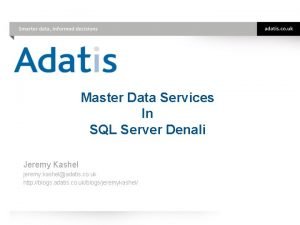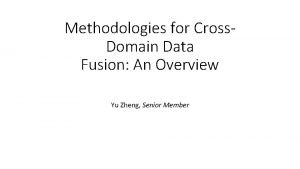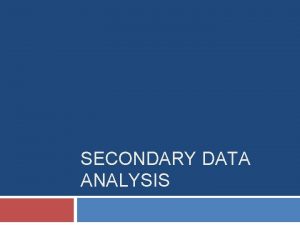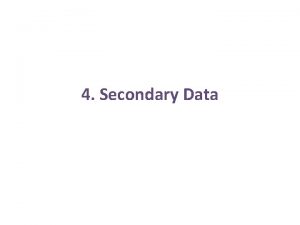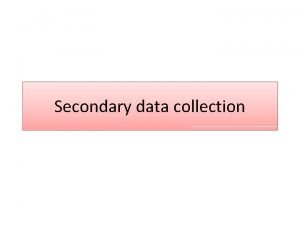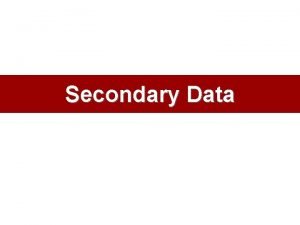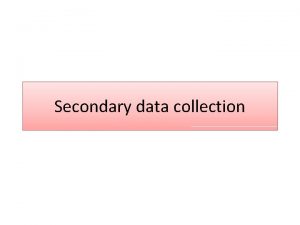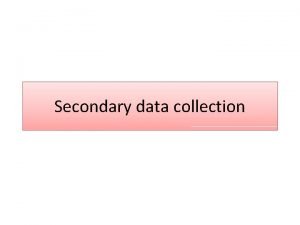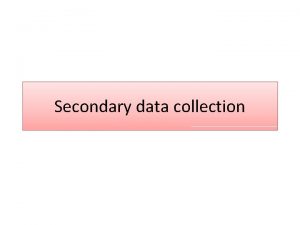SECONDARY DATA ANALYSIS Overview What is secondary data










- Slides: 10

SECONDARY DATA ANALYSIS

Overview What is “secondary data analysis”? How do you do it? What are the advantages and disadvantages?

What is it? (Hint: You’re already doing it) Secondary data analysis � Analyzes data from an existing data set Data you did not collect yourself (colleague, collaborator, professor) Data from a study focused on something else (primary analyses/papers already complete) Data collected for some other purpose (medical records, transcripts, etc. ) � Also called “primary analysis of existing data” or “archival data analysis” Distinguishes hypotheses from merely re-testing the same

Data Sets: Examples Inter-university Consortium for Political and Social Research (ICPSR) � http: //www. icpsr. umich. edu/icpsrweb/ICPSR/acce ss/subject. jsp � Catalogue of many public data sources Midlife in the United States (MIDUS) � http: //www. midus. wisc. edu/ � National being longitudinal study of health and well-

Components 1. Permission � Often requires a “data usage agreement” Rules about which analyses will be conducted, authorship, timeliness � May require IRB approval 2. Data dictionary � Protocol, measures, descriptive statistics � Quality varies: Non-existent, paper files, Excel, PDF 3. Data file � SPSS, Excel, SAS



Challenges Upfront investment: Varying quality of data dictionaries and collaborators Imperfect measures � You might want a quality measure of extraversion, and all they have is a single item on optimism Politics: Some psychology departments quantify science in terms of studies-per-paper rather than papers-per-study may be viewed as lesser science, or may require theses/dissertations to use “original” data collection

Opportunities Upfront investment = delayed gratification Efficient on many levels � Implementation, publishing, funding Significance � High-quality studies � May begin by asking the PI, “What is the most important finding in the data set you’ve never had time to publish? ” Can be symbiotic (mutually beneficial) � Own posters/presentations/publications, PI is happy for added productivity (publications are good, helps

Also: 13+ conference posters/presentations, 5+ promotions, 4 students advancing on to higher degree programs, 5+ students who were able to attend a national conference Salzman study as of 9/26/16 Funded Grant Failed Aim 1 Article in Special Issue Manuscript PI Funded Grant Data Set Manuscript Submitted Mentees Masters Thesis Funded Grant Manuscript Submitted External Collaborators Manuscript Submitted Article Funded Grant Honors Thesis Article Manuscript Article
 Sources of content analysis
Sources of content analysis Data cleaning problems and current approaches
Data cleaning problems and current approaches Data quality and data cleaning an overview
Data quality and data cleaning an overview Data quality and data cleaning an overview
Data quality and data cleaning an overview Chapter 1 overview of financial statement analysis
Chapter 1 overview of financial statement analysis Master data services overview
Master data services overview Microsoft master data services
Microsoft master data services An overview of data warehousing and olap technology
An overview of data warehousing and olap technology An overview of data warehousing and olap technology
An overview of data warehousing and olap technology Trajectory data mining an overview
Trajectory data mining an overview Methodologies for cross-domain data fusion: an overview
Methodologies for cross-domain data fusion: an overview





